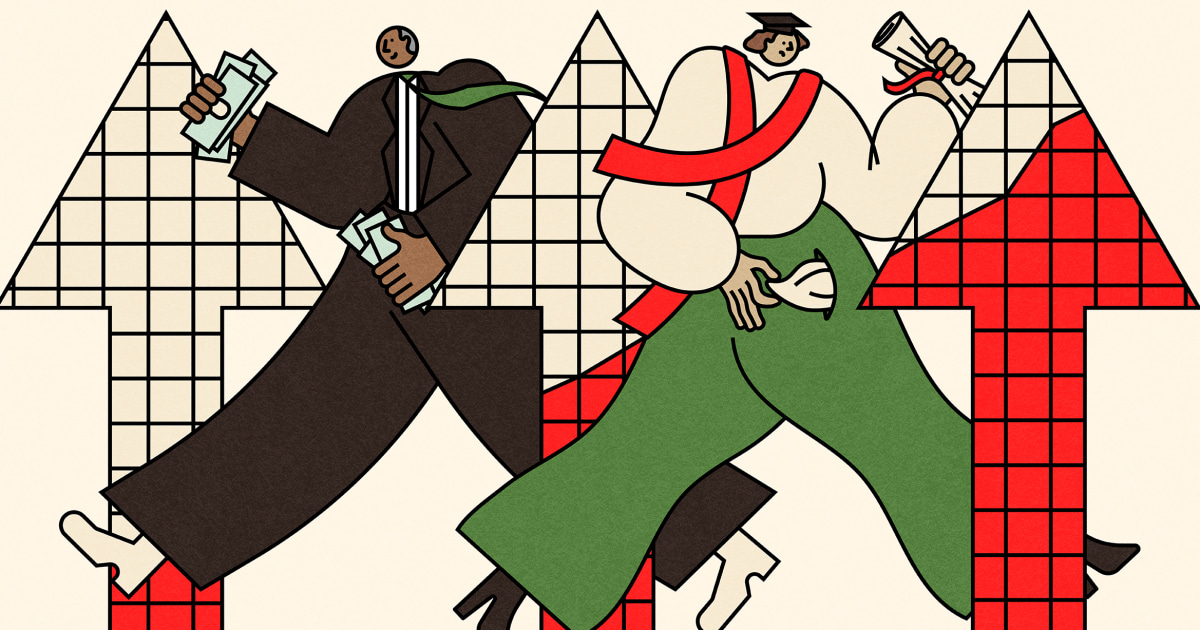
This story about tuition increases was produced by The Hechinger Report, a nonprofit, independent news organization focused on inequality and innovation in education.
Like chief financial officers at universities and colleges everywhere, David Jewell is having a stressful winter.
The senior vice president for business affairs and finance at Cleveland State University, Jewell is trying to constrain any tuition increase for next year at the same time that inflation is pushing up costs and staff shortages are forcing wages and benefits higher.
It’s a squeeze that comes at the worst possible time for higher education, as enrollment has declined by nearly a million students since the start of the pandemic. The last thing it needs is to increase its own prices.
“Families and their earnings haven’t fully recovered yet, especially as the student population we’re more focused on today tends to be first-generation, lower socioeconomic status, more diverse,” Jewell said.
On the other side of the ledger, “we’ve never dealt with this level of inflationary pressure and this kind of extremely competitive labor market.”
As a result, according to experts and early evidence, the next consumer product likely to cost Americans more will be a college education.
After several years when they’ve been flat or up only slightly, “there’s absolutely going to be an increase in tuition and fees,” said Jim Hundrieser, vice president for consulting and business development at the National Association of College and University Business Officers.
Citing the higher cost of everything from energy to food, plus upward pressure on wages and benefits, several institutions have already announced tuition and fee hikes for next year as high as 4.7 percent, while also raising prices for meal plans and housing — which, at public four-year universities, are already higher than in-state tuition. Many other colleges will set their rates this month.
Some aren’t even waiting until the fall to raise their rates. Virginia Tech, for instance, increased meal plan costs by 9 percent this semester to help cover a pay raise for dining hall workers.
Students and their families had been largely enjoying a break from such shocks. College costs outpaced inflation by 28 percent at public institutions and 19 percent at private nonprofit ones in the decade preceding the pandemic, according to the National Center for Education Statistics. But those relentless higher-than-inflation tuition hikes came to a halt in the fall, when the College Board reports that tuition rose at less than the Consumer Price Index.
That sudden restraint was not entirely a choice. It was forced on colleges and universities desperate to reverse an unprecedented decline in enrollment and fend off anger over Covid-related restrictions on the in-person services they could offer. It was also enabled in part by $74.8 billion in various federal relief funds.
And it may prove short-lived.
The University of Virginia has announced that it will raise undergraduate tuition and fees by 4.7 percent next year and another 3.7 percent the year after that, citing the costs of inflation and salary increases for faculty and staff; room and board charges will also each rise by around 4 percent.
Texas Christian University’s board of trustees approved a 4.5 percent tuition increase in response to what Chancellor Victor Boschini called, in an email to the campus, “escalating operational costs and rising rates of inflation.”
Lafayette College in Pennsylvania announced that it will raise tuition by 4 percent next year; Loyola of Chicago, by nearly 4 percent.
The board of trustees of the University of North Carolina Wilmington voted to increase tuition for nonresident students by 3 percent, housing rates by 3.5 percent and meal plan charges by 5.1 percent. The University of North Texas System board of regents put off a vote about tuition but agreed to raise dining costs by 3 percent and housing fees by 2 percent for 2022-23.
Washington State University’s board has proposed a 2.5 percent tuition increase. And the University of Illinois is raising housing rates by about 2 percent and tuition by just under 2 percent for in-state and 2.5 percent for out-of-state incoming freshmen.
Most of these tuition hikes still remain below the rate of inflation, which is hovering at around 7 percent. But many follow this year’s more moderate increases and freezes. At the University of Illinois, for instance, tuition had been flat for all but one year since 2015, and at UVA increases during that period averaged less than 2 percent a year.
Already-enrolled students now may face bigger bills than they had anticipated. And Americans are also dealing with higher prices for many other things.
“What this does bring is a greater challenge for students that come from families that are struggling,” Jewell said.
Only a dwindling number of students pay the published tuition; 82 percent at private nonprofit and 55 percent at public four-year universities and colleges get institutional financial aid, according to the College Board.
Research suggests that consumers remain sensitive to the sticker price, however.
In an annual national survey of first-year students conducted by an institute at UCLA, more than half said the cost was a very important reason they picked the college they’re attending; only a school’s academic reputation and job-placement record mattered more. A separate survey by the College Board and the consulting firm Art & Science Group found that more than half of high school students ruled out colleges because of the published price.
That report was published in 2012, and information has since become more readily available to students about what they will actually have to pay for their education after discounts and financial aid — assuming they know where to find it or have a parent or college counselor who can help them.
“My suspicion is that there are students not getting that advice,” said Alex Bloom, a research director at the education consulting firm EAB, who focuses on strategic pricing and financial aid strategy — namely, students whose own parents didn’t go to college or who go to high schools where the college counselors are thinly stretched.
As they set next year’s tuition, however, colleges and universities are stuck facing the same high levels of inflation in key commodities and services as everyone else.
Energy prices, including those for fuel oil, electricity and natural gas, are up by 29.3 percent over the last year, according to the Bureau of Labor Statistics, and food prices by 6.3 percent.
“Universities are not immune from these higher food costs, even if we buy in bulk,” Jewell said. “Dining plans will have to go up. We can be creative about things like trying to minimize food waste and about the menu choices to be more economical when prices are up on certain items. But we’re going to have to pass on at least a portion of that extra cost to students and their families.”
There are also new expenses, on top of the pre-existing ones, for dealing with the continuing pandemic and adding technology to provide remote instruction.
Far more students require mental health counseling, for instance. A third have been diagnosed with depressive disorders (two times pre-pandemic levels) and nearly 40 percent with generalized anxiety (one and a half times pre-pandemic), researchers at the University of California, Berkeley, and the University of Minnesota found.
Universities and colleges “are being pushed to spend more, just when they don’t have any more to spend,” said Richard Garrett, chief research officer at the higher education research and consulting firm Encoura.
One relief valve is that governors and legislatures are proposing boosting what they earmark for public higher education. Governors in Colorado, Kentucky, Missouri, New York and other states have called for spending more on public colleges and universities.
States collectively have increased higher education funding by 6.5 percent since last year, according to the State Higher Education Executive Officers Association — the biggest single increase since before the last recession.
Some of this largesse comes with the condition that institutions freeze tuition. That’s a stipulation in the budget increases proposed by Kansas Gov. Laura Kelly and South Carolina Gov. Henry McMaster. Already, the University of South Carolina has announced that it will not increase tuition in the fall.
California Gov. Gavin Newsom has proposed 5 percent budget increases in each of the next five years for the state’s public universities and colleges as long as they meet certain goals, including lowering the cost of attendance. The California State University system is promising that it won’t raise its tuition next year.
Well timed and welcome though it may be, however, this additional state aid may not be enough to cover the higher costs that universities and colleges are facing, said Robert Kelchen, head of the Department of Educational Leadership and Policy Studies at the University of Tennessee, Knoxville. Many institutions may, at best, end up largely standing still.
“The good news for public higher education is that state funding will be pretty high this year. But even a 5 percent increase in state funding won’t keep up with inflation,” Kelchen said.
In Massachusetts, for example, the 1.9 percent bump in state appropriations for universities and colleges is “nowhere near enough” to cover rising utilities, labor and other costs, said Andrew Mangels, vice chancellor for administration and finance at the University of Massachusetts Amherst, which has proposed a tuition increase of 2.5 percent for in-state and 3 percent for out-of-state students in the fall.
On the other hand, the state budget increases for higher education are a contrast to when outlays were being slashed during the recession that began in late 2007, said Jennifer Delaney, director of the Forum on the Future of Public Education at the University of Illinois at Urbana-Champaign.
“It’s not a period of growth. These are not golden times. But given the enormity of the pandemic, given the enormity of the enrollment decline, standing still is a win,” Delaney said.
Meanwhile, some decisions by governors are creating more, not less, financial pressure. Even though Idaho Gov. Brad Little is recommending an increase in higher education funding, for example, he’s also calling for a 5 percent increase in pay for state employees; the added money for Idaho’s public universities and colleges would cover only half of that expense, Board of Education President Kurt Liebich told the legislature’s Joint Finance-Appropriations Committee. Liebich said students may have to make up the difference in tuition.
The kinds of persistent labor shortages Little said he is trying to address with his across-the-board pay raises are complicating many universities’ financial woes by forcing them to increase salaries and restore benefit programs discontinued at the start of the pandemic. Duke and Georgetown universities, for instance, which stopped matching employees’ retirement contributions — a $47 million-a-year expense at Georgetown alone, the university said at the time — have both reinstated the perk.
Employees are demanding more. Some, including graduate and teaching assistants at American, Brown, Columbia, Georgetown and Harvard universities, have formed labor unions — after years of pushback that eased when they became essential during the pandemic — and made inroads through collective bargaining in winning higher pay and benefits.
Those victories have spilled over onto campuses where graduate students aren’t unionized but are also getting raises. Princeton University has announced that it will increase graduate fellowship rates and stipends next year by about 25 percent.
A coalition of labor unions representing 525,000 workers in higher education came together last year to demand improved pay and working conditions, among other things.
“Everyone is saying, ‘Well, we can’t go without another pay raise,’” Cleveland State’s Jewell said.
So even where students will be paying more, they could be getting less, as added charges are consumed by rising wages and higher commodity costs.
“It’s going to be difficult for colleges to cover inflation just with tuition increases,” Kelchen said. “They have to look at other ways to cut costs,” such as deferring maintenance, laying off employees and increasing class sizes.
“These are things students don’t want, faculty don’t want, but they may have to do them,” Kelchen said.
A few public universities pledged during the pandemic to keep tuition flat through at least next year, including Purdue University, the University of Nebraska system and the University of Vermont. They, too, will have to find ways to absorb their added costs.
Which leads to a bright spot in this grim picture: The money pressures on higher education are beginning to force spending reforms long considered but not actually made.
The University of Massachusetts system, for example, centralized purchasing for its five campuses in 2020 and had already saved just under $34 million by the middle of last year, said Lisa Calise, senior vice president for administration and finance. It also automated some back-office functions.
“With every challenge comes opportunity,” Calise said. “Some of those are experiments that are happening in this environment out of necessity.”
Universities and colleges are also likely to get serious about trimming programs with low enrollments and offering new ones that are in demand, often through less-expensive hybrid models that combine online and in-person teaching, said Garrett, at Encoura.
The pressure of covering higher costs without hugely increasing prices “is going to concentrate minds,” he said. “There’s a cost and productivity problem in higher education that for the last few decades has been a sleeping problem, and maybe what’s happening now will make a difference.”
Source: | This article originally belongs to Nbcnews.com










